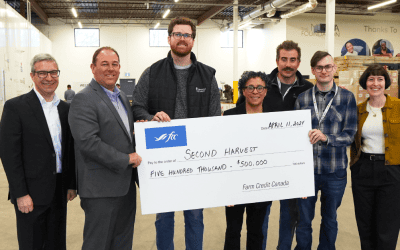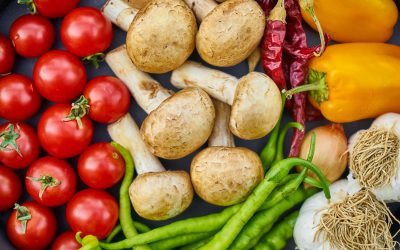In the summer of 2021, a partnership between Second Harvest and Arctic Co-operatives Limited (Arctic Co-ops) was formed. Together, we delivered 61,700 pounds of rescued food from the Greater Toronto Area directly to community members and food banks throughout Nunavut by sealift. The remote communities that received shipments were so grateful—explaining that anything we can send them helped—that we did it again the moment that the sea ice melted and ships could go north in the summer of 2022.
This is the story of how Second Harvest and Arctic Co-ops partnered for a second year to ship food rescued by Second Harvest in spring 2022 to send on three different sailings to the shores of dozens of Nunavut’s remote communities throughout the summer.

From Spring in Southern Canada to Summer in Nunavut: Organizing a Logistical Feat
The Harvest Journal team had the pleasure of connecting with Marie-José Mastromonaco, Second Harvest’s Head of Operations for Quebec and Nunavut. When we spoke in early July 2022, the first summer shipment (10,785 pounds of food rescue; the second sealift was set to deliver 32,690 pounds) had already left the port in Montreal and was sailing north on its two-week journey to the first communities receiving Second Harvest’s donation.
“This is an amazing project for the simple reason that these communities are so far away that for anything to be shipped, we start planning in April for the first sail at the end of June when the sea ice melts,” Marie-José said.
“All of that time is organizing and overcoming very challenging logistics. We have to find the products that have a best-before date that is far away enough for it to make sense to ship. But of course, we’re dealing with rescued food surplus that most often is coming near its best-before date.”
“From the moment that we decide that those are the products that we have to send and they want them, they won’t get them for 4 or 5 months. So it’s not like when we have food surplus in Toronto, it leaves the warehouse and a few hours later, many organizations receive the food. For us, 10 organizations will receive the food, but in months.”
Arctic Co-op and NSSI Ship Second Harvest’s Food Rescue to Nunavut
The shipping company is Nunavut Sealink and Supply Inc. (NSSI), an Inuit majority-owned Nunavut-based company with a sizeable fleet of multipurpose cargo ships and tankers. NSSI’s main shareholder is Arctic Co-op, Second Harvest’s partner. These Arctic Co-ops are independent stores in Nunavut communities that represent the interests of thousands of Inuit members and sell and distribute local foods, traditional arts and crafts and furs.
“A lot of the communities don’t have grocery store facilities, but the ones that do, it is the Arctic Co-op,” Marie-José said. Once Second Harvest organizes and packs the food rescue for each community, the GetPaq puts it in the sea can for that community, packs it on the NSSI vessels and ships them north to communities, regardless if they have a store or not there. These hamlet communities don’t have ports though, so the sea cans are often dropped right on the beach and community members unload and distribute them.
Sending Non-Perishable Rescued Food to Northern Canada
When we spoke, Marie-José was in the middle of coordinating the next shipment of 26 pallets or 32,690 pounds of non-perishable food and supplies. This required dividing and labelling each shipment by pallets to be delivered to nine individual communities, including Nunavut’s capital of Iqaluit as well as Cambridge Bay, Clyde River, Sanirajak, Kugluktuk, Qikiqtarjuak and others, set to receive this second shipment. A lot of the first logistics in rescuing the suitable donations is being handled by the team led by Ian Gibbon at Second Harvest.
All the food being shipped is shelf-stable and includes products that the Inuit communities will use. Some of the shipments had canned goods, including tuna and dried goods, such as cereal, oatmeal, baby cereal, as well as baby puree and vitamins. All of this rescued food was donated to Second Harvest by organizations and businesses that, for one reason or another, had a surplus.
“We’re sending pallets so we have to think that we’re sending it to a community of 1,000 people and those people are 150-200 families, so they won’t use all of that cereal, for instance, all in one week. It has to last in time for months. So all of that logistical planning has to revolve around best before dates to make sure that the products are going to last and are good for their cultural diet.”
Locals Receiving Food Rescue Shipments in Nunavut
Marie-José explained that finding folks in those remote hamlets who can actually receive, unload, distribute and store the donations is the most challenging part of the Arctic shipments. “Say someone somewhere in Nunavut opens a food bank, but then they don’t receive food for months until summer’s melt, the food banks or other community organizations are often run by volunteers, which sometimes makes it difficult to stay functional. Then we need to make another connection. It happens a lot, unfortunately.”
Marie-José explained why it can be so hard to find community members to receive donations in the first place. “It’s very logistically challenging to coordinate with such remote places,” she said. “Phone lines [or landlines] exist, but it is very hard to reach anyone and there is a language barrier, plus the internet is spotty or non-existent in some parts. It makes things extra complicated.”
That’s another reason why Arctic Co-op is so essential to making this partnership work. But even those communities that don’t have an Arctic Co-op might receive shipments from our partnership together. From the Arctic Co-op’s 2021 annual report: “Additionally, we helped facilitate the delivery of food bank contributions for the people in Clyde River, NU despite not having a Co-op to support in that community; it was simply the right thing to do. Arctic Co-operatives worked together in partnership with Second Harvest and Food Banks Canada to help overcome the distribution challenges of the Arctic and supply food to several communities.”
Waiting for Summer Shipments in Remote Nunavut Communities
“If you miss the boat, you miss the boat!” Marie-José said of shipping goods north every summer. The NSSI ships are already full of other sea cans with items like cars, clothing, building materials, snowmobiles and all kinds of deliveries that people bought throughout the past year and they’re on the first boat up there. “Everything is sent by sea cans on boats,” she said. “Unless it’s sent by plane, but that’s very expensive so most people wait for summer, especially for the heavy stuff.”
Sea cans are most often dropped right on the beach. “Community members unload and distribute everything,” she said. “They don’t have a port like the port of Montreal; they don’t have the infrastructure for that.”
“Most communities are just happy that we’re thinking of them. Without our partners though, we wouldn’t be able to help them. And once we helped them once, it honestly feels so amazing for Second Harvest to be able to and be allowed to help them. And they need the help.”
“I thank you very much and I wish you many blessings for your good work to lessen the hunger in the world.”
—Dorica, Chesterfield Inlet, Nunavut





